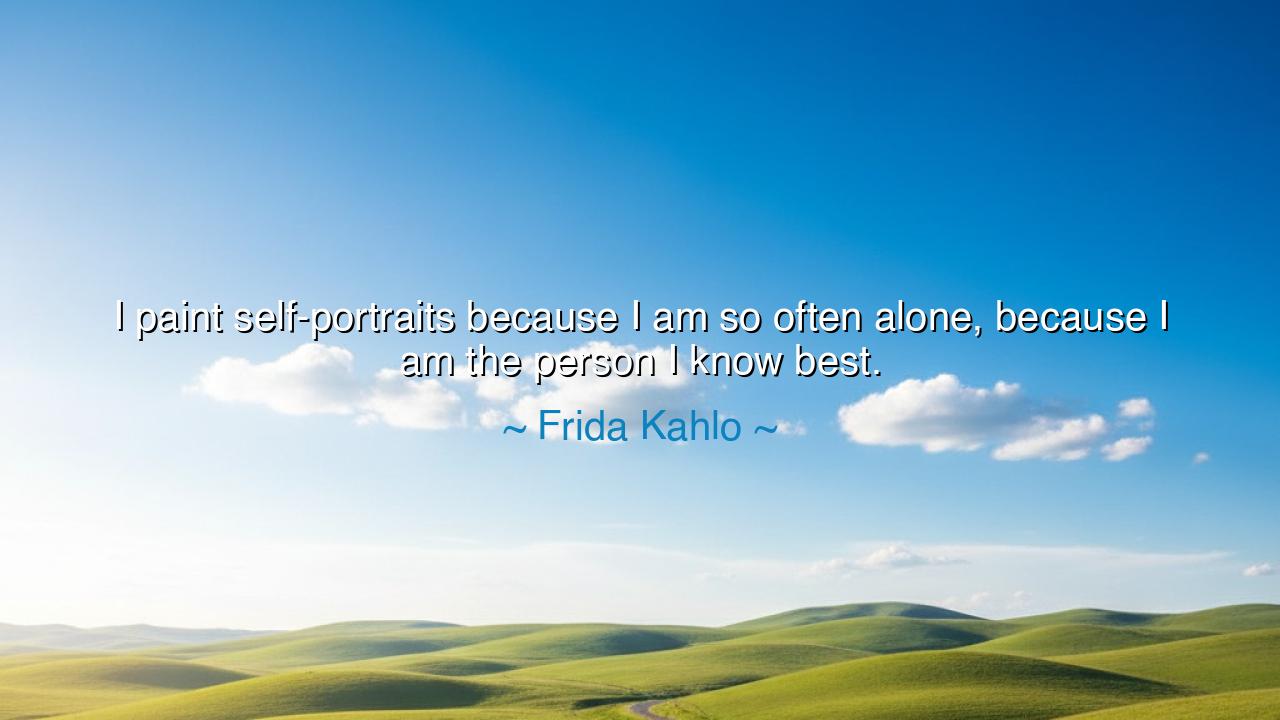
I paint self-portraits because I am so often alone, because I am
I paint self-portraits because I am so often alone, because I am the person I know best.






"I paint self-portraits because I am so often alone, because I am the person I know best." These words from Frida Kahlo resonate with a deep truth about the nature of self-expression and the profound intimacy that comes with facing oneself. In this statement, Kahlo reveals the core of her artistic journey—her solitude and her unwavering connection to her own inner world. To paint a self-portrait, in its purest form, is to turn inward, to confront one's own truth, and to capture that essence on canvas. It is a deeply personal act, not just of creation, but of self-discovery, where the artist does not seek to replicate the outer world but instead explores the landscape of the soul.
In the ancient traditions, art was not merely a means of visual representation but a form of soul-searching. The great Greek sculptors such as Phidias or Praxiteles, though they often depicted gods or heroes, also captured the deepest aspects of the human form and spirit. Their works were not just images; they were reflections of the inner human experience, capturing the vulnerability, the strength, and the beauty of the human soul. Like Kahlo, these artists sought to bring their inner worlds to life through their craft, revealing to the viewer not only the external form but the truth of the individual’s existence. Art, for them, was not about the world they saw—it was about the world they felt, the world within.
Kahlo's journey into self-portraiture was one born of both necessity and self-exploration. Her life was marked by pain, both physical and emotional, and it was through her art that she processed the depths of her suffering. She suffered severe injuries from a bus accident, which left her in constant physical pain. Yet, it was the emotional scars of her turbulent relationship with Diego Rivera and the isolation she often felt that truly defined the emotional depth of her work. In self-portraits, she painted not only the outer self but also the complex landscape of her internal world. Each stroke of the brush captured the essence of her inner turmoil, her dreams, and her desires, making her art a window into the unspoken and the unseen parts of herself.
Consider the ancient oracle of Delphi, where the inscription "Know thyself" was carved. The sages who sought wisdom at Delphi were urged to look inward, to confront the depths of their own being before seeking answers in the external world. Frida Kahlo, too, in her solitude, embraced the ancient wisdom of self-knowledge. To paint oneself is not simply a gesture of narcissism or vanity—it is an act of profound self-reflection, a way of understanding one's own soul. By painting herself, Kahlo did not simply present a likeness; she gave us access to her most intimate thoughts, her fears, her hopes, and her contradictions. She used the canvas as a mirror to explore the emotional and physical wounds she carried with her, a symbolic healing through art that transcended time and place.
The truth in Kahlo’s words is that self-knowledge requires solitude. It is only when one is alone, free from the distractions of the world, that the depths of the inner self can be fully understood. Like the great mystics who retreated into the wilderness or the silence of the temple to hear the voice of the Divine, Kahlo retreated into her art to hear her own soul. She faced the raw, unfiltered emotions that many would shy away from, and she painted them in bold colors, expressing her inner strength and vulnerability. Her self-portraits were not acts of escape—they were acts of confrontation, of sitting face-to-face with the truth of who she was.
The lesson that Kahlo imparts is profound: self-expression is a sacred act. It is through our own solitude and inner exploration that we come to understand our true selves. We are not bound by the expectations of the world, nor by the opinions of others. True art, true wisdom, and true strength come when we turn inward and ask, "Who am I?" Just as Kahlo painted her truth, so too must we all engage in the act of self-reflection, whether through art, meditation, or quiet contemplation. In these moments, we can access the deepest parts of ourselves, the parts that are often hidden from the world and even from our own understanding.
For those who seek to embrace this journey of self-knowledge, take the time to reflect on who you are beneath the surface. Solitude, in its deepest form, is not loneliness—it is the opportunity to truly connect with yourself. Find a form of expression, be it through writing, art, or movement, that allows you to express the feelings, the truths, and the dreams that reside within. Do not shy away from the pain or struggles that may emerge, for they are often the very things that define who we are and what we are meant to become. Like Kahlo, embrace the rawness of your emotions, and let them guide you to a deeper understanding of yourself. It is only through this process of self-exploration that we can truly live and truly create.






AAdministratorAdministrator
Welcome, honored guests. Please leave a comment, we will respond soon